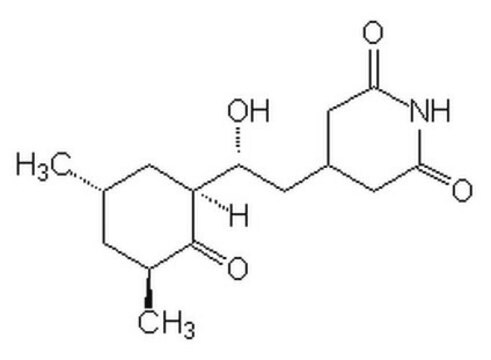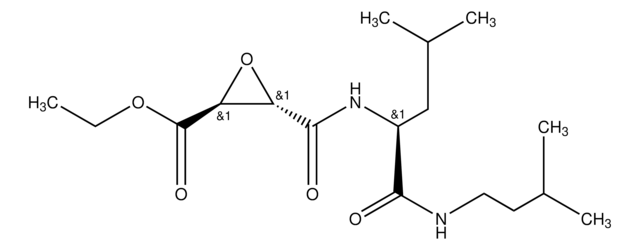239764
Cycloheximide, High Purity
Antifungal antibiotic that inhibits protein synthesis in eukaryotes but not in prokaryotes.
Synonyme(s) :
Cycloheximide, High Purity
About This Item
Produits recommandés
Niveau de qualité
Essai
≥98% (HPLC)
Forme
solid
Puissance
3.4 μM Ki
Fabricant/nom de marque
Calbiochem®
Conditions de stockage
OK to freeze
Couleur
white
Solubilité
chloroform: soluble
ethanol: soluble
methanol: soluble
Conditions d'expédition
ambient
Température de stockage
10-30°C
InChI
1S/C15H23NO4/c1-8-3-9(2)15(20)11(4-8)12(17)5-10-6-13(18)16-14(19)7-10/h8-12,17H,3-7H2,1-2H3,(H,16,18,19)/t8-,9-,11-,12+/m0/s1
Clé InChI
YPHMISFOHDHNIV-FSZOTQKASA-N
Description générale
Actions biochimiques/physiologiques
hFKBP12
Avertissement
Reconstitution
Autres remarques
Lu, Q., et al. 1996. Arch. Biochem. Biophys.334, 175.
Chow, S.C., et al. 1995. Exp. Cell Res.216, 149.
Cotter, T.G., et al. 1992. Anticancer Res.12, 773.
Takano, Y.S., et al. 1991. J. Pathol.163, 329.
Waring, P. 1990. J. Biol. Chem. 265, 14476.
Informations légales
Mention d'avertissement
Danger
Mentions de danger
Conseils de prudence
Classification des risques
Acute Tox. 2 Oral - Aquatic Chronic 2 - Muta. 2 - Repr. 1B
Code de la classe de stockage
6.1A - Combustible acute toxic Cat. 1 and 2 / very toxic hazardous materials
Classe de danger pour l'eau (WGK)
WGK 3
Point d'éclair (°F)
Not applicable
Point d'éclair (°C)
Not applicable
Certificats d'analyse (COA)
Recherchez un Certificats d'analyse (COA) en saisissant le numéro de lot du produit. Les numéros de lot figurent sur l'étiquette du produit après les mots "Lot" ou "Batch".
Déjà en possession de ce produit ?
Retrouvez la documentation relative aux produits que vous avez récemment achetés dans la Bibliothèque de documents.
Les clients ont également consulté
Notre équipe de scientifiques dispose d'une expérience dans tous les secteurs de la recherche, notamment en sciences de la vie, science des matériaux, synthèse chimique, chromatographie, analyse et dans de nombreux autres domaines..
Contacter notre Service technique







